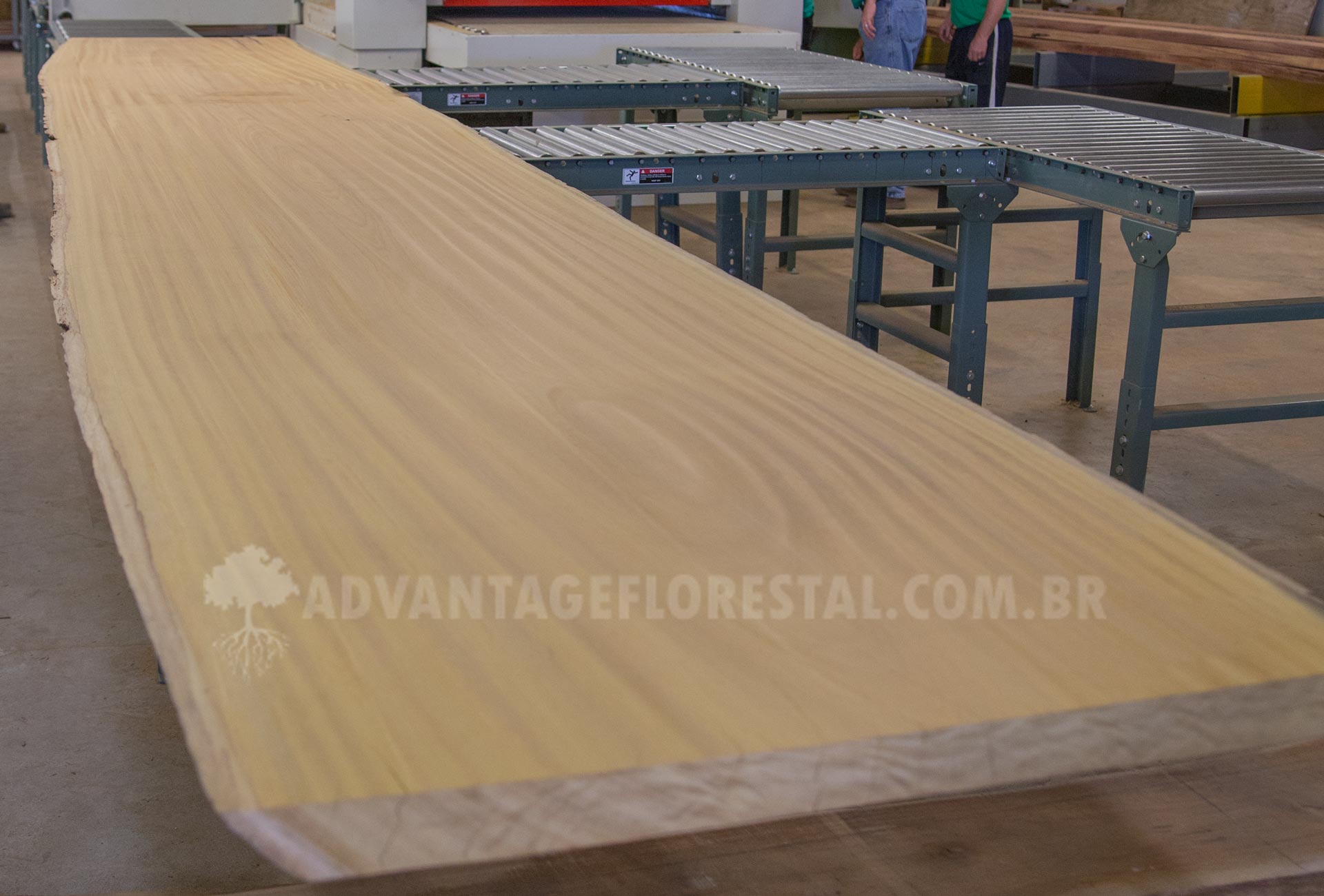
[php_everywhere]
Tatajuba Wood Slabs
Tatjuba is a wide, tall tree with very few branches in the lower sections which makes it a perfect candidate for a clear grade slab. Tatajuba has seen little movement on the market as lumber as of yet but is starting to get noticed because of its beauty and durability. The sapwood is thin and remains a yellowish white. The heartwood grain is usually very straight and can exhibit some of the “ribboning” pattern much like that of Sapele or Sipo. The light tawny brown heartwood is very uniform which shows off the figure from autumnal to spring growth very well. Since the tree is so straight with few low branches these slabs can get rather large. The straight grain makes surfacing and sanding a pleasure but some tear out can occur in the more figured spots. If this occurs slowing down the feed rate should solve the problem. Cross cutting and ripping is done without much cause for concern but some grain tension can stress saw blades and a riving knife is always recommended. It takes a finish well and can be sanded to a fine finish. We expect in the near future that this wood will see an increase in use as a decking and siding. Furniture builders will appreciate how the wood can be manipulated and anyone looking for a wood that is good consistency in color will love it as a slab. Our biggest and straightest logs are chosen to be sent out as a slab because it shows the beauty of the entire tree. Some of the best reasons to cut the highest quality logs into slabs are because: • Slabs have the highest yield of any form and using the most wood out of a tree is imperative to sustainable harvest which we are committed to • A slab that comes from a lesser quality log will be prone to be less stable • Voids in some logs means that they would not be suitable for slabs We believe that offering some of our Tatajuba in the highest possible yield is imperative to keep our wholesalers competitive in an ever changing wood world. Our experience with Tatajuba means you can always be assured that we will supply you the very best slabs. Just imagine being able to sell a new and exciting wood in a new and exciting form. This can be the thing that gives you an edge over your competitors and something very few mills can offer with integrity and quality. Give us a call or email us to see what we have available or what we are expecting to be available shortly.
Common Name: |
Cow-wood, Amarelao, or Bagasse |
Botanical Name: |
Bagassa Guianensis |
Indigenous to: |
Info coming soon |
Modulus of Rupture: |
2,752,000 lbf/in2 |
Shrinkage: |
Radial: 4.4%, Tangential: 5.9%, Volumetric: 9.6%, T/R Ratio: 1.3 |
How is it dried: |
kiln-dried (KD) |
Is it dried quickly: |
No : normal to slow is recommendedHigh risks of distortion in presence of highly interlocked grain. During drying, spacer sticks may stain the wood. |
Stability: |
Moderately Stable |
Exterior Wood Recommendation: |
Use class ensured by natural durability: class 4 – in ground or fresh water contact Species covering the use class 5: Yes This species naturally covers the use class 5 (end-uses in marine environment or in brackish water) due to its high silica content.Against dry wood borer attacks: does not require any preservative treatment In case of risk of temporary humidification: does not require any preservative treatment In case of risk of permanent humidification: does not require any preservative treatment |
Fastening Method: |
Nailing / screwing: Yes but pre-drilling is required Gluing: Yes |
Ecosystem impact: |
This wood species is not listed in the CITES Appendices or on the IUCN Red List of Threatened Species. |
Toxicity and allergic reactions: |
Although severe reactions are rare, Tatajuba has been reported to cause skin irritation. |
Odor: |
Info coming soon |
Products we manufacture using this species: |
Decking, flooring, dimensional lumber, E4E, S4S, RS (Rough Sawn), deck tiles, and table slabs |
Other common uses: |
Flooring Current furniture or furniture components Ship building (planking and deck) Ship building (ribs) Cabinetwork (high class furniture) Wood frame house Interior joinery Interior panelling Sliced veneer Sleepers Hydraulic works (fresh water) Exterior joinery Exterior panelling Bridges (parts in contact with water or ground) Bridges (parts not in contact with water or ground) Heavy carpentry Turned goods Stairs (inside) Vehicle or container flooring Moulding Note: Interlocked grain may be troublesome in the use of this wood. |
Susceptibility to |
|
Dry Wood borers: |
Durable – sapwood demarcated (risk limited to sapwood) |
Fungi: |
Class 1 – very durable |
Termites: |
Class D – durable |
Treatability: |
Class 3 – poorly permeable |
Janka Hardness: |
|
More Product Information